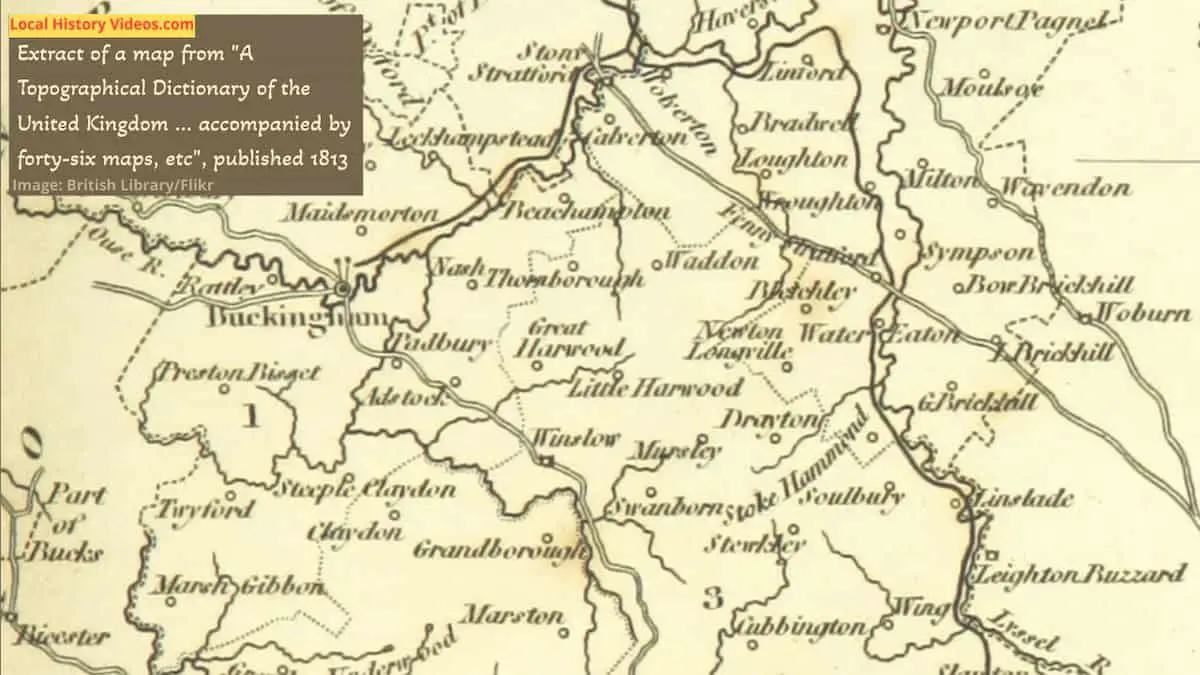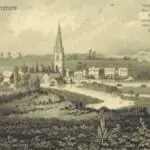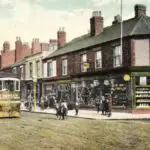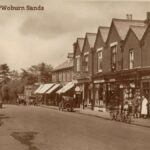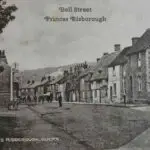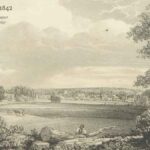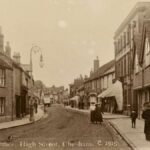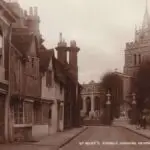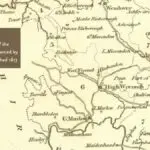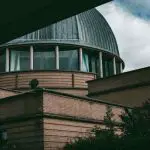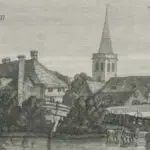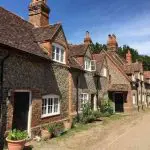Glimpse history through old images of Bletchley, Buckinghamshire, England.
Model Education 1946
Local children make puppets and put on a play, in footage recorded a year after the end of World War II.
Model Education (1946) – British Pathé on YouTube
Duke of Edinburgh 1952
Duke Of Edinburgh Tours Bletchley Aka Duke Opens Playing Field (1952) – British Pathé on YouTube
Telegraph Poles 1965
A new machine used by the Post Office (GPO0 makes plating telegraph poles much easier.
Telegraph Pole Planter (1965) – British Pathé on YouTube
A Bit of Bletchley History
Extract from: History and Topography of Buckinghamshire Comprising a General Survey of the County, Preceded by an Epitome of the Early History of Great Britain, by James Joseph Sheahan
Published in 1862
Pages 489 – 490
BLETCHLEY or Blechley parish contains 3,150 acres, whereof 1,180 form the township of Bletchley, and 1,040 the hamlet of Water Eaton.
The population of the township in 1851 was 443; and that of the hamlet 241 souls.
The soil is clay or loam.
The parish is intersected by the London and Northern Western Railway, of which line the Bletchley and Fenny Stratford Station is situated here.
The Village, which stands 13 mile W. by S. from Fenny Stratford, is scattered and mean – looking consisting chiefly of poor thatched cottages.
It is in two sections, called ” the green, ” and ” the town, ” which are nearly half a mile apart.
The parish is remarkable for the longevity of its inhabitants.
Pillow lace is made here.
Bletchley is a polling place at the county elections.
The Bletchley Junction Railway Station is situated half a mile from the village of Bletchley, one mile from the town of Fenny Stratford, and 46 miles from London.
The station covers about three acres of ground; from 80 to 100 men are usually employed at it; and from 60 to 70 passenger trains pass through it daily.
There are branch lines from this junction to Bedford, Oxford, Buckingham, and Banbury.
The landed property of this parish is stated to have been given by King William II. to Walter Giffard, Earl of Buckingham, in 1092. At the death of Walter, the second Earl, in 1167, the estate came to Richard de Clare, Earl of Hereford, by the marriage of Roesia, his sister, she being one of his heirs ( See p. 365 ). Helena, daughter of the Earl of Hereford, brought it in marriage to John de Grey, who died seised of it and many other manors in 1211. Reginald de Grey, his great- grandson, marrying the daughter of Henry Longchamp, became in her right, Baron of Wilton; and, dying in 1307, bequeathed to John, Lord Grey of Wilton, his eldest son, the manor of Over or Church Bletchley; and to his younger son, who became Lord Grey of Ruthyn, divers other manors.
The descendants of Lord Grey of Wilton held this property through ten generations, during more than 400 years, until 1603, when the lands of Thomas, the last Lord Grey of Wilton, upon his attainder, were forfeited to the Crown.
In 1606, King James I. bestowed the Bletchley estate upon George Villiers, afterwards Duke of Buckingham.
During the Commonwealth it was sold as confiscated lands, to Sir Philip Skippon.
George Villiers, the second Duke of Buckingham, recovered the estate at the Restoration of Charles II.; and in 1674, he conveyed the manor to Thomas Willis, MD., a very eminent physician, grandfather of Browne Willis, Esq., LL.D., the celebrated antiquary, who became possessed of WATER EATON.
This was anciently the principal manor in Bletchley, and it is recorded among the lands bestowed by the Conqueror on Geoffrey, Bishop of Constance.
The lands of this prelate reverted to the Crown in the reign of the second William ( See p. 396 ), and soon after wards Water Eaton ( including Fenny Stratford and Church Bletchley ) was granted by the Crown to the family of Cauz, by the serjeanty of keeping the King’s hawks.
In the Red Book of the Exchequer it is stated, that in 1210, Roger de Cauz then held Eaton by the serjeanty of Falconry. This Roger de Cauz had a grant of a Market at Eaton, in the fifth of King John ( 1104 ). The De Cauz family continued to hold these lands till the reign of King Henry III., ” and, ” writes Lipscomb, ” unquestionably built the church of Bletchley, for Roger de Cauz presented Walter de Cauz, probably his kinsman, to that church in 1220. ” In the Testa de Nevill, which was compiled in the early part of the reign of King Henry III., Eaton ( which is supposed to have always included Fenny Stratford ) was held by Sir John de Grey, by serjeanty, as also Bletchley; but the latter place was held by the usual military service of the period. This Sir John was the second son of Henry de Grey, Lord of Codnor, and Sheriff of Bucks and Beds in 1239. Sir John de Grey, lord of Eaton, died in 1266, seised of Eaton, Great Brickhill, Wavendon, Weston, & c. He appears to have resided partly in Lavendon parish, and partly at Water Hall, which stood in the meadows, about midway between Water Eaton and Fenny Stratford bridge.
He had a charter for a Fair at Fenny Stratford, in 1269, which is the first time that place occurs by name in any record.
Reginald, his eldest son and heir, by his marriage, as before mentioned, became lord of Wilton – upon – Wye, Co. Hereford; and was summoned to Parliament as Baron Grey de Wilton. He died seised of Water Eaton, Fenny Stratford, Bletchley, Great Brickhill, and Simpson manors.
John de Grey, his son, died in 1323, possessed of these manors, and those of Walton, Wolston, and Stoke Hammond, in this county; besides the castles of Wilton and Ruthyn, and other manors.
We have already seen that the large estates in this locality of the last Lord Grey of Wilton, were forfeited to the Crown, then granted to the Villiers’s, and afterwards sold to Dr. Willis Browne Willis’s grandson, John Willis Fleming, Esq., sold the manors of Bletchley, Water Eaton, and Fenny Stratford to the Rev. Philip Barton, of Great Brickhill; who devised them to Philip Duncombe Pauncefort, Esq. They now belong to Sir Philip Duncombe, of Great Brickhill, created a Baronet in 1859.
Page 491
The following were amongst the Rectors of Bletchley: – William Lambeth, instituted in 1351, died in 1360 a Prebendary of St. Stephen’s College, Westminster. Thomas de Ettesle, 1358, was in 1352 made the First Master of St. Benet’s College, Cambridge. William Heulett, 1364, became Prebendary of Empingham, in Lincoln Cathedral. William Styvecle, or Stewkley, LL.B., 1396, was a Prebendary in St. Paul’s, London. John Bernard was a Prebendary in Lincoln, and died Rector here in 1419. David Hopton, 1477, became a Canon and Archdeacon of Exeter. William Webster, LL.B., 1526, was a Prebendary in the Church of Lincoln. Thomas Sparke, BD., 1578, was collated to the Archdeaconry of Stowe in Lincoln Cathedral in 1575, but quitted it after he became Rector of Bletchley, where he died and was buried in the chancel of the church. He was installed into Sutton – in – Marisco Prebend in 1582. Martin Benson, 1727, became Archdeacon of Berks, Prebendary of Durham, and Bishop lof Gloucester, and died in 1752.
William Cole, the well – known Cambridge Antiquary, was presented to this Rectory by Dr. Browne Willis in 1753: he resigned in 1768. Three of the Rectors were of the family of Willis, after the patronage of the church came into the hands of the celebrated antiquary of that name.
The last Rector of the name, Thomas Willis, presented by Dr. Willis’s Trustees in 1768, was grandson of the antiquary.
More about Buckinghamshire
- Old Images of Buckinghamshire, England
- Old Images of Wolverton, Buckinghamshire
- Old Images of Woburn Sands, Buckinghamshire
- Old Images of Princes Risborough, Buckinghamshire
- Old Images of Olney, Buckinghamshire
- Old Images of Newport Pagnell, Buckinghamshire
- Old Images of Chesham, Buckinghamshire
- Old Images of Bletchley, Buckinghamshire
- Old Images of Aylesbury, Buckinghamshire
- Old Images of Amersham, Buckinghamshire
- Milton Keynes: Old Photos & Film
- Old Images of Beaconsfield, Buckinghamshire
- Old Images of Marlow, Buckinghamshire
- High Wycombe History: Old Photos & Film
- Buckinghamshire, England: Local History Resources

